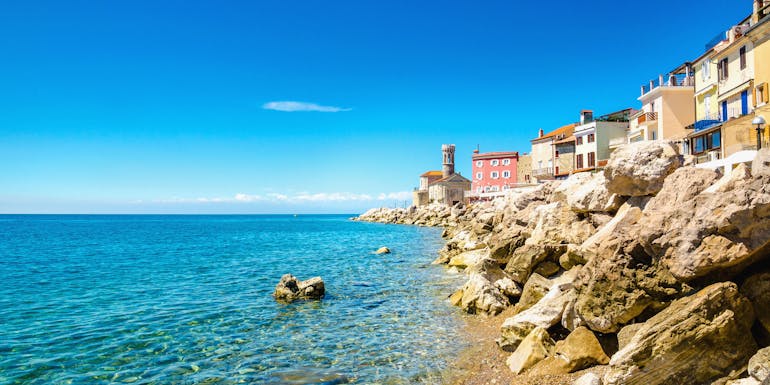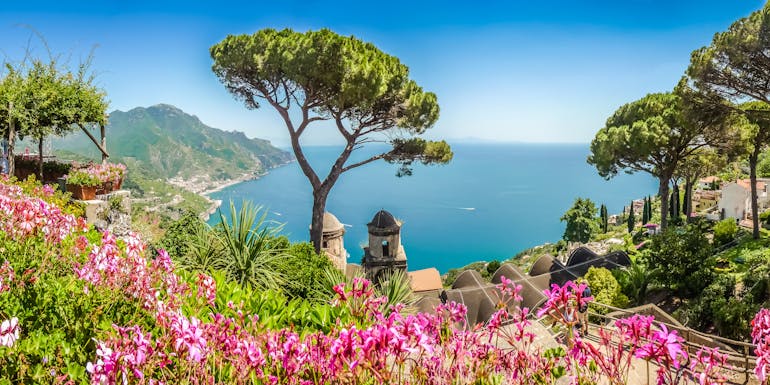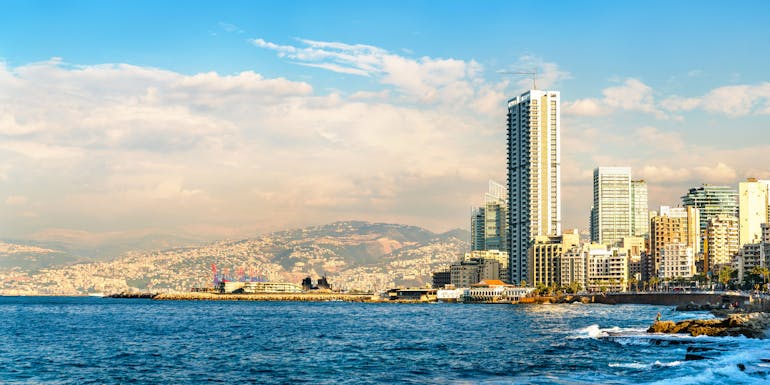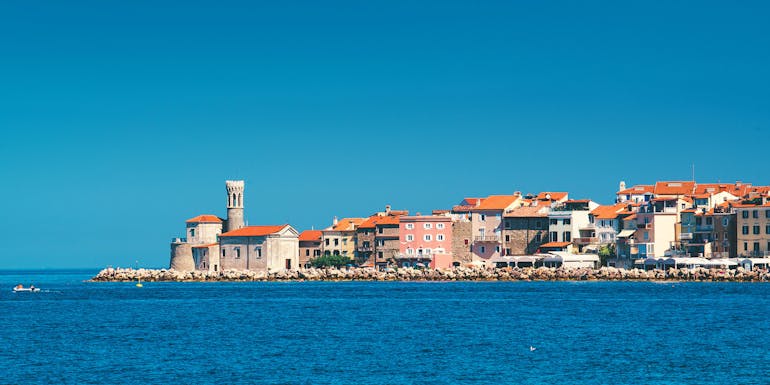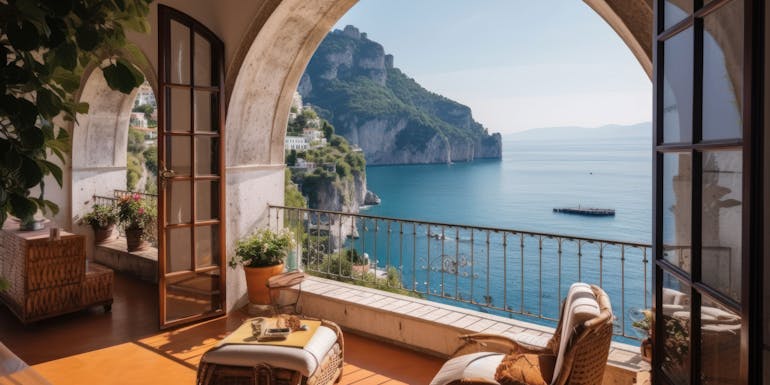
Nadine Walder, 20 July 2023
Public space
The Mediterranean climate and its influence on the indoor climate
Basically, the Earth can be divided into five main climate zones: tropical, subtropical, temperate, subpolar and polar. The conditions in these climate zones have a direct influence on the indoor climate. The different climate conditions should be taken into account during the construction of buildings, and structural measures should be adapted to the outdoor climate in order to ensure a healthy climate indoors. In addition to the method of construction, different room air-conditioners can also be useful depending on the climate zone in which you live.
In the first two parts of our blog series on climate conditions worldwide, we looked at different climate classifications and the influence of the temperate zone and the tropical and subtropical zones on the indoor climate. This third part also looks at the subtropical zone, focusing specifically on the Mediterranean climate, the influence of the Mediterranean on the indoor climate and the climate conditions in Lebanon and in Slovenia in particular.
Read on to find out about:
- Characteristics of the Mediterranean climate: hot summers and mild, wet winters
- The climate in Lebanon: mountains divide the country into different climate areas
- The types of climate in Slovenia: Alpine, continental and Mediterranean
- Effects of the Mediterranean climate on the indoor climate
Characteristics of the Mediterranean climate: hot summers and mild, wet winters
The Mediterranean is commonly known for its azure coasts, charming vineyards and lush olive groves. But what creates the perfect setting for this picturesque landscape? The answer lies in the Mediterranean climate, a characteristic weather pattern that characterises the regions around the Mediterranean in particular.
Geographical distribution
The Mediterranean climate is mainly found in regions around the Mediterranean, in countries such as Spain, Italy, Greece, Lebanon, Turkey and the coast of Slovenia. However, this climate also prevails in parts of California, parts of South Africa, Chile and Australia, to name but a few.
Hot, dry summers
The Mediterranean climate is characterised by hot, dry summers. These summers are often characterised by cloudless skies, lots of sunshine and warm to hot temperatures. Generally, very little rain falls during this season, resulting in parched landscapes and rivers and streams drying up, for example. However in the coastal regions, there is often a refreshing sea breeze to offer some respite from the heat.
Mild winters with rainfall
The Mediterranean climate is characterised by mild, wet winters. Although temperatures are cooler during this season, they rarely drop below freezing. In winter, it rains more often, rejuvenating the landscape and helping create the lush vegetation that characterises regions with a Mediterranean climate. This seasonal precipitation also supports agriculture, including viticulture and the cultivation of Mediterranean plants such as olives, citrus fruit and figs.
Seasons in transition
The Mediterranean climate also has two transitional seasons: spring and autumn. Spring is a time of renewal when flowers bloom and fill the landscape with vibrant colours. Autumn, on the other hand, marks the transition from summer to winter, with cooler temperatures and picturesque scenes as the leaves change colour and fall from the trees. These transitional periods highlight the dynamic nature of the Mediterranean climate and make it even more attractive.
The influence of the Mediterranean
The Mediterranean plays an important role in shaping the climate in the regions along its coast. Its proximity acts as a moderating factor, regulating temperature extremes and creating a maritime influence. The thermal inertia of the sea also contributes to the slow heating up and cooling down of the coastal areas and creates a more stable climate.
The climate in Lebanon: mountains divide the country into different climate areas
Lebanon lies on the east coast of the Mediterranean and is a country with a rich history, breathtaking landscapes and a diverse climate. From snow-capped mountains to sunny coastal plains – the topography of Lebanon helps create a unique combination of weather patterns. The geographical position of Lebanon has a significant influence on its climate. The country is characterised by a narrow coastal strip, a mountainous hinterland and the fertile Bekaa Valley.
Most of Lebanon has a Mediterranean climate. The coastal regions benefit from the moderating influence of the sea which keeps temperatures mild. Summers on the coast are pleasantly warm with average temperatures of 24 to 26 degrees Celsius, though they can sometimes be as high as 36 °C. Humidity can get up to 90% in summer. Winters in the coastal regions are characterised by high levels of precipitation and temperatures between 9 and 15 °C. Humidity reaches levels between 55 and 70%.
In the mountainous interior of Lebanon, especially the Mount Lebanon mountain range, cooler temperatures prevail on account of the altitude. In winter, the peaks are capped with snow. There is more rainfall in the mountainous regions and most of the annual precipitation falls in winter, usually in the form of snow.
The Bekaa Valley that lies between Mount Lebanon and Anti-Lebanon (also a mountain range) has its own unique microclimate. The climate has continental characteristics. Summers here are hotter and drier than they are in the areas to the west of the mountains. Winters are colder and also drier: in addition, snow also falls here in winter.
Like many regions worldwide, Lebanon has also been affected by the impact of climate change. Rising temperatures, changing precipitation patterns and the increasing frequency of extreme weather events pose risks to ecosystems, agriculture and water resources. Heatwaves, reduced snowfall and longer dry spells exacerbate the water shortage problem and affect crop yields, intensifying socio-economic challenges.
The types of climate in Slovenia: Alpine, continental and Mediterranean
Located at the heart of Europe, Slovenia has picturesque landscapes and charming cities as well as a fascinating variety of climatic conditions. From snow-capped peaks to Mediterranean coastal areas, Slovenia has a diverse climate. The climate in Slovenia is influenced by its unique geographic location. Situated at the crossroads of the Mediterranean, Alpine and Pannonian regions, the country is made up of a remarkable mixture of different climate zones. The varied topography characterised by mountains, high plains and coastal areas helps create the country’s different climate patterns.
Generally speaking, Slovenia has a seasonal climate with four seasons. The north-western part of Slovenia is dominated by the Julian Alps which form a breathtaking backdrop and characterise the climate of the region. Here, you will find an Alpine climate with cold winters with intensive snow and pleasant mild summers.
Moving eastwards from the Alps, Central Slovenia enjoys a continental climate. In this region, you will find Ljubljana, the country’s capital and largest city. Here, there are cold and wet winters with occasional snowfall and hot, dry summers. In spring and autumn, the weather is mild and pleasant.
Finally, the Slovenian coast which stretches along the Adriatic is characterised by a mild Mediterranean climate. The pleasant climate on the coast brings warm, dry summers and mild winters. Snow hardly ever falls in this region.
Effects of the Mediterranean climate on the indoor climate
The Mediterranean climate affects not only the climate outdoors but also the indoor climate in the areas where it prevails. The Mediterranean climate is known for its pleasant weather conditions which are characterised by hot, dry summers and mild, wet winters. While this climate offers many benefits for life outdoors, it also presents a number of challenges when it comes to maintaining a pleasant climate indoors. The effects of the Mediterranean climate on temperature, humidity and air quality call for the careful planning of construction methods and the use of appropriate room air-conditioners.
The intense heat in summer can penetrate indoors and cause temperatures to rise, making it difficult to create a cool and pleasant atmosphere in homes and other indoor spaces. That is when fans or other air conditioners can prove useful. In addition, use of the natural air flow is another effective method. In the Mediterranean climate, evening temperatures are often cooler. Opening windows and using cross-ventilation techniques can help fresh air circulate and cool things down. Fans can be placed by windows or balcony doors as an effective way to bring the cooler outside air indoors.
The Mediterranean climate is also characterised by fluctuations in humidity which can affect people’s comfort and health indoors. In Lebanon, for example, the humidity is high all year round. Here, the use of dehumidifiers can be useful for removing excess moisture from the air. The diversity of the four seasons means that a range of different air conditioners can generally be used. So in spring, for example, air purifiers can be used to counteract the high pollen count.
The Mediterranean climate also influences architecture and construction in general. Traditional architecture in the Mediterranean region is designed to adapt to the climate. Houses are often built with thick walls and small windows to keep the heat out and the inside cool.
The Mediterranean climate not only influences the climate outdoors but also shapes the indoor climate in the areas where it prevails. Architecture, natural ventilation and the use of air conditioners are important aspects that shape the indoor climate in the Mediterranean region. These adaptations help create a pleasant and comfortable living environment in which people can enjoy the benefits of the Mediterranean climate to the full.
In the next part of this series, we will present to you the boreal climate and introduce you to the climate conditions in Finland.
*This article was written with the collaboration of the following Stadler Form distributors:
- Lebanon: Mint Consulting & Contracting
- Slovenia: eBull d.o.o, https:/stadlerform.si/
If you have questions related to indoor room climate, please get in touch with us. Or subscribe to our newsletter to regularly get informed about current topics regarding indoor climate, experience reports or Stadler Form insights.
